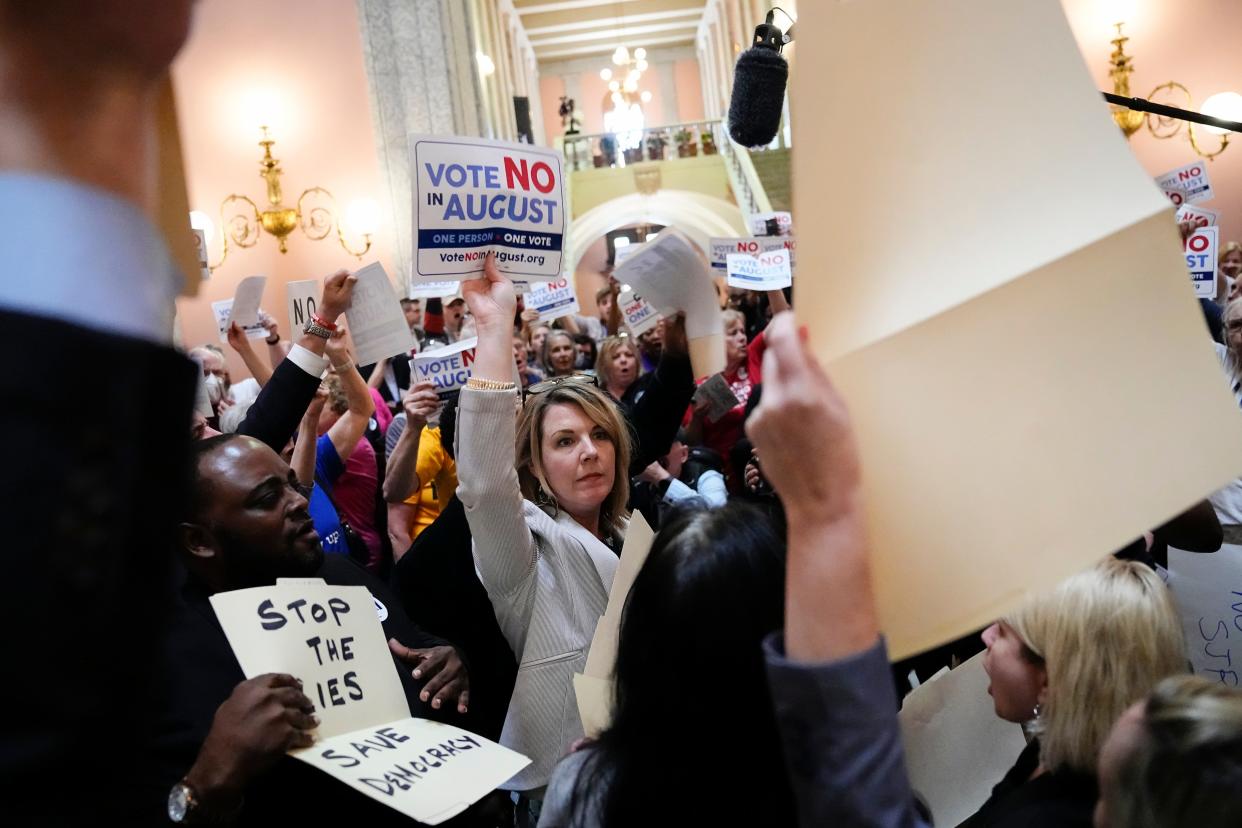Can Ohio Democrats win statewide offices? They can't even field a Statehouse farm team

- Oops!Something went wrong.Please try again later.
- Oops!Something went wrong.Please try again later.
Thomas Suddes is a former legislative reporter with The Plain Dealer in Cleveland and writes from Ohio University. tsuddes@gmail.com
It’ll soon be 30 years since an Ohio Democratic misstep, and the retirement of Democratic Ohio House Speaker Vern Riffe, handed control of Capitol Square to Republicans, who’ve generally ruled the Statehouse roost ever since.
Sure, Ohioans in 2006 elected Democrat Ted Strickland governor — but for one term, replacing him with Republican John R. Kasich. And yes, also in 2006, Ohioans gave Democrat Sherrod Brown the first of his (so far) three U.S. Senate terms.

Then in 2008, Ohio House Democrats led by future Cuyahoga County Executive Armond Budish captured control of Ohio’s House – but for just two years. And in 2008, as well as 2012, to the continuing consternation of out of state observers, Ohioan backed Barack Obama for president.
Still, fundamentally, Ohio Democrats’ trajectory has been on a downward trend – at least as to Statehouse office – since the party’s disastrous 1994 nomination of then-state Sen. Rob Burch, a Tuscarawas County Democrat, for governor.
Ohio Democrats can't field a Statehouse farm team
Burch only drew 25% of the statewide vote against incumbent Republican Gov. George V. Voinovich’s 72%; Voinovich racked up a win even in Democrats’ Appalachian fortress, Athens County.

True, Sherrod Brown remains a senator, and Democrats periodically have won statewide executive office and state Supreme Court seats. But the governorship, especially in tandem with General Assembly majorities, is – if shrewdly deployed – the determining force in Ohio politics.
In that connection, Republicans have controlled the state Senate continuously since November 1984, and the Ohio House of Representatives – but for the two-year Budish interlude – since November 1994.
Yes, GOP gerrymandering of General Assembly districts has ensured GOP majorities in the General Assembly. Still, Republicans captured the state Senate in 1984 with districts that Democrats had drawn.
Meanwhile, Democrats have failed to field a Statehouse farm team, standing by as potential gubernatorial candidates.

In contrast, four-term GOP Gov. James A. Rhodes was long-time state auditor. Bob Taft, governor from 1999 through 2006, had been secretary of state.
Kasich, a long-time member of Congress from suburban Columbus, had served in the state Senate, as had Gov. Mike DeWine, from Greene County’s Cedarville. DeWine also served in Congress, and as Ohio’s lieutenant governor, as U.S. senator, and as Ohio attorney general, before landing the governorship in 2018.
Can Ohio Democrats win statewide offices?
Today, Republicans hold all of Ohio’s statewide elected executive officers, and – with DeWine term-limited out of the governorship in 2026 – several of those GOP officeholders are poised for higher office (or in the case of Secretary of State Frank LaRose, of Upper Arlington, running for one – Democrat Brown’s U.S. Senate seat.) Meanwhile, it appears that Attorney General David Yost is an all-but-certain GOP prospect to run for governor in 2026.
A third Republican, State Auditor Keith Faber, is no slouch in the ambition department. Comparatively, State Treasurer Robert Sprague has been low-key, but that calls to mind a time-tested Statehouse habit: Never discount the quiet ones.
Leaving aside Strickland’s 2006 victory, those of several other Democrats, also in 2006, Brown’s Senate victories then and in 2012 and 2018, and several Ohio Supreme Court wins since then, the last time Democrats nominated and elected a statewide non-judicial officeholder except for Brown was in a 2008 special election for attorney general, which Democrat Richard Cordray won.
But in 2010, DeWine unseated Cordray by just under 49,000 votes. And Corday, Democrats’ 2018 candidate for governor, lost to DeWine for that office, too.
True, there’s no glory is ending up an also-ran in contests for A.G., auditor, secretary, or treasurer.
Even Statehouse regulars with sharp memories likely would have a hard time remembering which Democrat ran, for example, for state treasurer in 2022 (outgoing Marion Mayor Scott Schertzer) or for secretary of state (Forest City Council member Chelsea Clark.)
Have an opinion? How to submit a letter to the editor for The Columbus Dispatch
Ohio Republicans have been far better at filling out a farm team ready for deployment when an opening arises in a statewide office. For instance, state Sen. Theresa Gavarone, a Bowling Green Republican, is a prospective successor to LaRose as secretary of state.
Understandably, Ohio Democrats are now focused on 2024’s Senate and presidential ballot. But unless they want to stay locked out of the Statehouse, Democrats need to start thinking about potential 2026 statewide candidates. Now.
Thomas Suddes is a former legislative reporter with The Plain Dealer in Cleveland and writes from Ohio University. tsuddes@gmail.com
This article originally appeared on The Columbus Dispatch: Why is the Democratic Party so weak in Ohio/ Thomas Suddes

